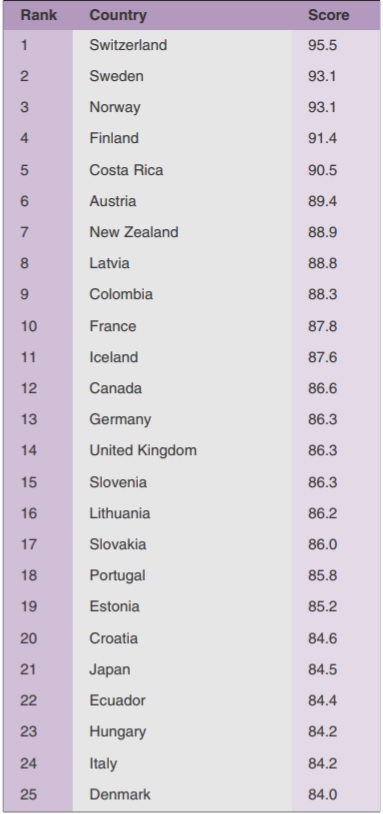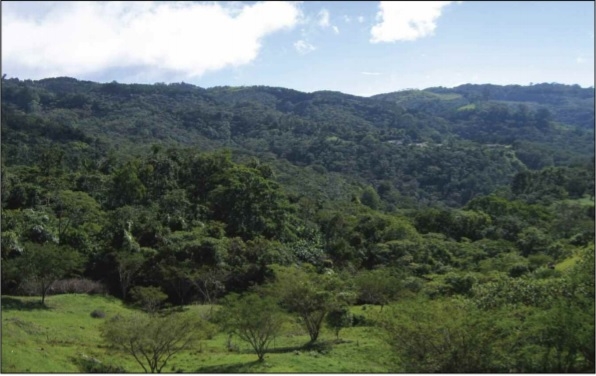Daniela Rivera and her colleagues are planting seeds of success in Nicaragua’s forests: millions of tree seeds. Rivera, vice-chair of a tree nursery, worked with six other nurseries during 2007 to plant more than 1.4 million trees. Each tiny sapling will ultimately supply forestry projects and plantations. Together, nurseries like Rivera’s are growing an industry that provides much-needed jobs and a steady income for rural residents. In addition, Rivera and her colleagues are following environmental best practices that will help sustain, rather than exploit, forests in Nicaragua.
Policy makers are discovering that protecting and maintaining their nation’s environment can benefit economic development, and a growing global movement is encouraging countries to treat natural resources as investments, similar to basic societal infrastructure. Marc Levy, a project scientist for NASA's Socioeconomic Data and Applications Center (SEDAC), said, “In the same way that a country would spend money every year to maintain its trains and roads, countries are starting to think of their water, forest, and soil resources as if they were capital assets. If they run them down, they’re going to pay a price.”
Nicaragua’s government now supports and encourages the tree nurseries, and this effort is just one example of how countries are investing in their environment. However, many governments like to see data before they decide where to invest. Policy makers need to know which resources are being successfully managed and which may need more protection. Some factors, such as air quality, are easy to monitor and regulate. But factors such as habitat degradation and ecosystem health are hard to track; without data, officials cannot easily remedy problems. “A lot of the things that matter most are hard to measure—things like halting deforestation, conserving freshwater quality, or preserving biodiversity,” Levy said. “It turns out that it’s very difficult to get data that lets you measure and compare environmental resources in a rigorous way.”
Measuring up
To overcome the difficulty of gathering environmental data, Levy and his colleagues at SEDAC partnered with the Yale Center for Environmental Law and Policy to locate data that were comparable worldwide. However, many governments lacked the resources or desire to measure environmental factors. “I think there’s kind of a chicken-and-egg problem going on,” Levy said. “Because many governments aren’t getting good measurements, they don’t set clear goals. And then, the fact that many countries don’t have goals undermines the incentives to measure these environmental factors.”
Consequently, to fill gaps in the data, Levy and his colleagues frequently had to consult specialists in different areas, such as marine fisheries, sustainable agriculture, water resources, and biodiversity conservation. The researchers also collaborated with various international agencies that gathered environmental information, such as the World Health Organization, the United Nations, and The Nature Conservancy.
Levy and his colleagues used the data to compile a pilot report in 2000, which ranked countries according to their environmental performance. As more data became available over time, the researchers refined subsequent reports to better match policy categories that many countries had established. They also revised the reports to define specific outcomes for governments to aim for. “It makes sense to start setting some targets and measuring progress,” Levy said. “These things can be tracked, if people put resources into gathering the data.”
For the most recent report, the 2008 Environmental Performance Index (EPI), the researchers tried to be as inclusive as possible, although there were some gaps. They could find sufficient comparable data for only 149 countries, leaving out more than 80. They also lacked data on some important indicators, such as wetlands loss and waste management. However, they added a number of new and improved indicators, including the measure of burned land area based on 1-kilometer- (0.6-mile-) resolution remote sensing data.
The 2008 EPI ranks countries based on two objectives. “Environmental health” assesses environmental conditions that directly affect human health: air quality, sanitation, and safe drinking water. “Ecosystem vitality” measures how well a country protects its natural resources and maintains healthy ecosystems. The objectives are broken down into twenty-five indicators, or specific outcomes, that policy makers can track over time. “These indicators represent realistic targets against which governments can compare themselves and measure their progress,” Levy said.
While most industrialized nations scored well in environmental health, some developing nations still struggle to provide basic infrastructure for human welfare. For instance, the United States scored 98.5 in environmental health; Nicaragua scored 72.9. But the scores also penalized unsustainable activity that destroys natural resources or generates unclean air. The United States continues to emit the most carbon dioxide per person, which factored into its ecosystem vitality score of only 63.5, falling below Nicaragua’s score of 74.0.
Healthy ecosystems, healthy people
The EPI did not look at human health and environmental quality in isolation. The index also assessed how human activity affected ecosystems by including indicators such as fishing intensity, or the amount of irrigation stress caused by farming. Alex de Sherbinin, a deputy manager at SEDAC, said, “For instance, if you’re not over-using water resources, you have more water for diluting waste streams that might go into waterways, which means you’re more likely to have functioning aquatic ecosystems. And you have more water for domestic consumption.”
More governments and funding agencies recognize the connections between ecosystems and human health, and they are beginning to formulate policies that incorporate environmental protections. One program, the Millennium Challenge Corporation (MCC), is a United States government foreign aid program that uses a variety of criteria to screen nations before distributing funds. Levy said, “Congress mandated that MCC include natural resource sustainability indicators as part of their screening process.” However, MCC officials were not able to gather sufficient environmental data, so they now rely on Levy and his colleagues for help. The researchers culled a subset of the EPI data to form the Natural Resource Management Index (NRMI). MCC officials can use this subset to assess whether candidate countries are doing enough to protect their ecosystems and maintain sanitation, safe drinking water, and low child mortality rates. “MCC has provided a pretty clear financial incentive to the developing countries that compete for those funds,” Levy said.
Even after countries receive funding, the MCC continues to evaluate their environmental performance using the NRMI, encouraging projects that foster environmental sustainability. In Nicaragua, for example, the effects of clearing land for agriculture become apparent each year during the hurricane season. During a hurricane’s heavy rain, deforested hillsides are more susceptible to landslides than are naturally forested hills. The MCC is encouraging reforestation in Nicaragua by funding tree nurseries like Rivera’s.
Raising awareness
The EPI provides another incentive by harnessing the power of competition. In addition to ranking countries overall, the index ranks countries within their geographical peer group. These peer groupings permit countries to compare themselves to neighboring nations that face similar issues or geographical challenges. De Sherbinin said, “If a country sees other countries in their geographic region performing better, then it gives them less grounds to dismiss the whole effort. They can see practices in other countries that might yield positive results in their own.” For instance, in addition to promoting reforestation, Nicaragua’s government is trying to emulate Costa Rica’s successful ecotourism industry. Properly planned ecotourism helps preserve biodiversity while creating jobs and generating money to improve urban and rural infrastructure.
But even within similar geographical groupings, each nation still faces different challenges. Policy makers require more than a static snapshot, so the EPI researchers created an interactive online version of the index. Policy makers can see exactly where they have been successful, or even adjust the weight of certain indicators to reflect particular values. Levy said, “If you’re the World Wildlife Fund, you might increase the weight for ecosystem vitality. Or, if you’re the World Health Organization, you might increase the weight for environmental health indicators.” Government workers can see how their country ranking might change if they improved certain indicators, allowing them to choose which areas are most practical for them to address first.
Because few global standards exist for maintaining environmental health or ecosystem vitality, the goal of the EPI is primarily to raise consciousness and encourage sustainable environmental development. Several countries, such as South Korea and Mexico, have evaluated the EPI to see how it might help them formulate policies that would protect natural resources without hindering economic development. “One of the reasons we produced the EPI was to create a framework for how countries could improve. Luckily, the situation is getting a bit better over time,” Levy said. The EPI is giving governments data that may help improve environmental conditions in their countries, while encouraging policy makers to invest in livelihoods that foster and preserve local natural resources.
References
Esty, D. C., M. A. Levy, C. H. Kim, A. de Sherbinin, T. Srebotnjak, and V. Mara. 2008. 2008 Environmental Performance Index. New Haven: Yale Center for Environmental Law and Policy.
Millennium Challenge Corporation. Women’s incomes and trees sprout up in Nicaragua. http://www.mcc.gov/documents/successstory -042308-resultsontheground-nicaragua.pdf
Sanderson, E. W., M. Jaiteh, M. A. Levy, K. H. Redford, A. V. Wannebo, and G. Woolmer. 2002. The human footprint and the last of the wild. BioScience 52: 891–904
For more information
NASA Socioeconomic Data and Applications Center (SEDAC)
2008 Environmental Performance Index (EPI)
Millennium Challenge Corporation (MCC)
World Data Center for Human Interactions in the Environment map gallery
| About the data | ||
|---|---|---|
| Data set | 2008 Environmental Performance Index (EPI) | |
| Parameter | Environmental indicators | |
| DAAC | NASA Socioeconomic Data and Applications Center (SEDAC) | |



